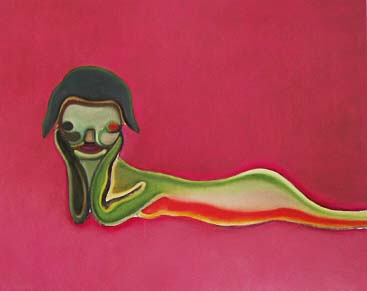|
Paintings that get close to the “quintessence” catalog Izumi Kato Galleria Astuni,Pietrasanta,Italy,2005 |
|
 |
|
The title of all Izumi Kato’s works is “Untitled”. By this means, no false association can be triggered by the title. In the case of Kato, the paintings are without a title in order to leave all interpretation to the viewers. It is as if the painter presents them with a white canvas. He nevertheless does leave his traces on the canvas. From 1998 to 1999, when he decided to become a painter, he painted a form that looked like a larva or embryo. After the portrait series “Good Face” in 1999, he in 2000 then produced paintings on which a man or a woman is recognizable. Since 2003 he has drawn forms that look like little children. Now he depicts human forms that go beyond the conventional framework. In the 1998 exhibition at the IBM-Kawasaki City Gallery, which was his artistic debut, he presented his early works of embryo-like forms. A Japanese critic, Takami Akihiko, who makes it his business to discover new young artists, immediately recognized his talent and wrote in the exhibition folder on Kato: “Kato’s extraordinary talent is manifest by the fact that his respect for realist artists is not only limited to a superficial reception, but that he consciously adopts a course to internalize this vivid experience.”★ The artist subsequently presented his 2001 solo exhibition at the Contemporary Art Center Art Tower Mito, characterized as one of Japan’s significant contemporary art museums. In this period he introduced couple-like forms. The exhibition’s curator, Kenji Kubota, wrote of Kato’s work: “The appeal of Kato’s paintings lies in the depth of human consciousness or in association with the energy that very primitive life itself possesses, a realm that cannot be explained by works, words or logic.”★★ Looking at the paintings, Kubota felt their shaman-like vital energy and responded with awe and respect. The way Kato’s career has developed is certainly exceptional, because up to then he had had only very few exhibitions. The art scene’s critics and curators recognized the artist’s strong inherent potential and expressed this in words. But they could not explain why Kato painted “the human form” or something similar. Here is where the comments by Tamaki Saito, a psychoanalyst who was very profoundly impressed by Kato’s works, could prove interesting. They were made during an interview with the artist on the occasion of his 2003 exhibition at the Fuchu Art Museum, in which the artists showed childlike forms. In his analysis, Saito compared Kato to Francis Bacon and pointed out what the two had in common. “The human form is actually ‘a sign of a relationship’ and ‘a sign of the psyche’ […] If for this reason you portray several human forms, an interplay comes about between ‘interiority’ and the ‘relationships’; ‘a story’ automatically emerges, which Bacon hated and avoided […] In order to keep the painting powerful and at the same time avoid the emergence of a story, ‘interiority’ and ‘meanings’ must be thoroughly removed from the picture plane. Which means a flight from the senses. The more distant the meaning is kept, the more intensely powerful the picture becomes. But it is not enough to be solely ‘without meaning’. It is important for a painting to be without meaning but, at the same time, to seduce your gaze. If, between the viewers and the works, a magnetic tension arises, the power of the pictures reaches its highest point. It is at this moment that ‘the human form’ can function as a potent gaze-seduction device. No matter which method is used, the picture that achieves the more intensive power is precisely ‘the right picture’.”★★★ The human form that excites the viewers’ attention should not produce a story in order to achieve ‘the right picture’. Izumi Kato, the artist, does not dare present a white canvas. He adds something to the canvas. The work has no title. But in my opinion, the owner of the painting must in future invent the invisible “story” in order to come closer to the ”quintessence”. Eri Kawamura Art historian, freelance curator, collector of Kato’s works Translation from Germany Jeanne Haunschild ★ Akihiko Takami, “From neoteny to cosmic birth”, Izumi Kato exhibition pamphlet for IBM-Kawasaki City Gallery, 1998 ★★ Kenji Kubota, “A Portrait of the Present”, Izumi Kato Exhibition leaflet for Contemporary Art Center Art Tower Mito, 2001 ★★★ Tamaki Saito, “Frontier Explorers on the Border”, Bijutsu Techo, June 2004, p 128 |
| - - - - TOP - - - - Copyright ERI KAWAMURA 2013 all rights reserved. |